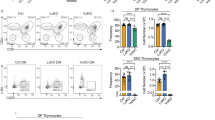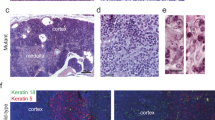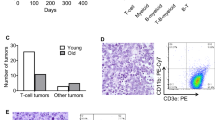Abstract
DEATH by apoptosis is characteristic of cells undergoing deletion during embryonic development, T- and B-cell maturation and endocrine-induced atrophy1. Apoptosis can be initiated by various agents1–5 and may be a result of expression of the oncosuppressor gene p53 (refs 6–8). Here we study the dependence of apoptosis on p53 expression in cells from the thymus cortex. Short-term thymocyte cultures were prepared from mice constitutively heterozygous or homozygous for a deletion in the p53 gene introduced into the germ line after gene targeting. Wild-type thymocytes readily undergo apoptosis after treatment with ionizing radiation, the glucocorticoid methylprednisolone, or etoposide (an inhibitor of topoisomerase II), or after Ca2+-dependent activation by phorbol ester and a calcium ionophore. In contrast, homozygous null p53 thymocytes are resistant to induction of apoptosis by radiation or etoposide, but retain normal sensitivity to glucocorticoid and calcium. The time-dependent apoptosis that occurs in untreated cultures is unaffected by p53 status. Cells heterozygous for p53 deletion are partially resistant to radiation and etoposide. Our results show that p53 exerts a significant and dose-dependent effect in the initiation of apoptosis, but only when it is induced by agents that cause DNA-strand breakage.
This is a preview of subscription content, access via your institution
Access options
Subscribe to this journal
Receive 51 print issues and online access
$199.00 per year
only $3.90 per issue
Buy this article
- Purchase on Springer Link
- Instant access to full article PDF
Prices may be subject to local taxes which are calculated during checkout
Similar content being viewed by others
References
Arends, M. J. & Wyllie, A. H. Int. Rev. exp. Path. 32, 223–254 (1991).
Smith, C. A., Williams, G. T., Kingston, R., Jenkinson, E. J. & Owen, J. J. T. Nature 337, 181–184 (1989).
Wyllie, A. H. Nature 284, 555–556 (1980).
Sellins, K. S. & Cohen, J. J. J. Immun. 139, 3199–3206 (1987).
McConkey, D. J., Orrenius, S. & Jondal, M. Immun, Today 11, 120–121 (1990).
Ryan, J. J., Danish, R., Gottlieb, C. A. & Clarke, M. F. Molec. cell. Biol. 13, 711–719 (1993).
Yonish-Rouach, E. et al. Nature 352, 345–347 (1991).
Shaw, P. et al. Proc. natn. Acad. Sci. U.S.A. 89, 4495–4499 (1992).
Hooper, M. L., Hardy, K., Handyside, A., Hunter, S. & Monk, M. Nature 326, 292–295 (1987).
Yewdell, J. W., Gannon, J. V. & Lane, D. P. J. Virol. 59, 444–452 (1986).
Clarke, A. R. et al. Nature 359, 328–330 (1992).
Walker, P. R. et al. Cancer Res. 51, 1078–1085 (1991).
Zhivotovsky, B. D., Seiliev, A. A. & Hanson, K. P. Int. J. Rad. Biol. 42, 199–204 (1982).
Kastan, M. B., Onyekwere, O., Sidransky, D., Vogelstein, B. & Craig, R. W. Cancer Res. 51, 5304–5311 (1991).
Kuerbitz, S. J., Plunkett, B. S., Walsh, M. V. & Kastan, M. B. Proc. natn. Acad. Sci. U.S.A. 89, 7491–7495 (1992).
Roy, C. et al. Expl. Cell Res. 200, 416–424 (1992).
Bertrand, R. Sarang, M. Jenkin, J., Kerrigan, D. & Pommier, Y. Cancer Res. 51, 6280–6285 (1991).
Fanidi, A., Harrington, E. A. & Evan, G. I. Nature 359, 554–556 (1992).
Iseki, R., Mukai, M. & Iwata, M. J. Immun. 147, 4286–4292 (1991).
Wyllie, A. H., Morris, R. G., Smith, A. L. & Dunlop, D. J. J. Path 142, 67–78 (1984).
Kastan, M. B. et al. Cell 71, 587–597 (1992).
Bienz, B., Zakut-Houri, R., Givol, D. & Oren, M. EMBO J. 3, 2179–2183 (1984).
McBurney, M. W. et al. Nucleic Acids Res. 19, 5755–5761 (1991).
Colbere-Garapin, F., Chousterman, S., Horodniceanu, F., Kourilisky, P. & Garapin, A.-X. Proc. natn. Acad. Sci. U.S.A. 76, 3755–3759 (1979).
van der Lugt, N., Robanus Maandag, E., te Riele, H., Laird, P. W. & Berns, A. Gene 105, 263–267 (1991).
Kaster, K. R., Burgett, S. G., Rao, R. N. & Ignolia, T. D. Nucleic Acids Res. 11, 6895–6911 (1983).
Author information
Authors and Affiliations
Rights and permissions
About this article
Cite this article
Clarke, A., Purdie, C., Harrison, D. et al. Thymocyte apoptosis induced by p53-dependent and independent pathways. Nature 362, 849–852 (1993). https://doi.org/10.1038/362849a0
Received:
Accepted:
Issue Date:
DOI: https://doi.org/10.1038/362849a0
This article is cited by
-
Combined absence of TRP53 target genes ZMAT3, PUMA and p21 cause a high incidence of cancer in mice
Cell Death & Differentiation (2024)
-
The power of an idea: Andrew Wyllie
Cell Death & Differentiation (2022)
-
Necroptosis, pyroptosis and apoptosis: an intricate game of cell death
Cellular & Molecular Immunology (2021)
-
Karonudib has potent anti-tumor effects in preclinical models of B-cell lymphoma
Scientific Reports (2021)
-
Radiation resistance in head and neck squamous cell carcinoma: dire need for an appropriate sensitizer
Oncogene (2020)
Comments
By submitting a comment you agree to abide by our Terms and Community Guidelines. If you find something abusive or that does not comply with our terms or guidelines please flag it as inappropriate.



